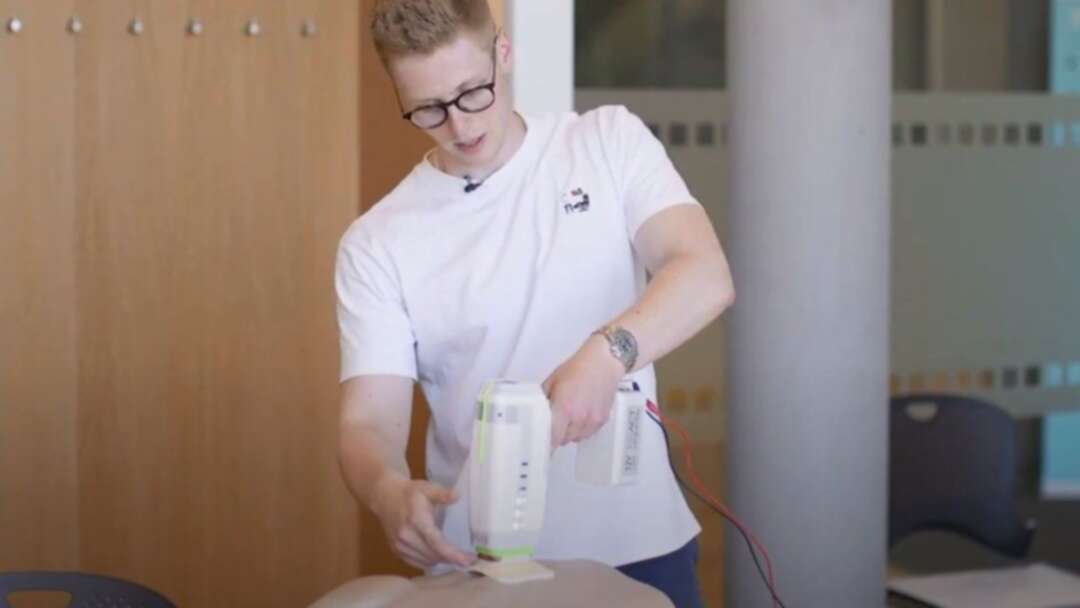-
Student From Loughborough University Designs A Life-Saving Device

BBC reported that a student, whose name is Joseph Bentley, from Loughborough University, has designed a potentially life-saving device that can be used to rapidly stop bleeding from stab wounds. Student
According to the BBC, he said that it was "a game-changer for first responders" and could save "hundreds of lives a year".
He has developed REACT, which uses pressure at wounds to prevent blood loss.
The product targets areas that are normally hard to treat, such as those in the armpit, groin and abdomen.
REACT consists of two parts - a medical-grade silicon sleeve, known as a "tamponade", and a handheld device called an "actuator". It can only be used in cases where the wound is open.
The tamponade is inserted into the wound, and the actuator is then connected and switched on to inflate and fill the wound.
The final year product design and technology student said by applying internal pressure to the wound, it takes less than 30 seconds to stop the bleeding. Student
He said it was key for the first people to a stabbing, which is often the police, to stop excessive blood loss while they wait for paramedics to arrive.
The BBC reported, citing the 22-year-old, from Essex as saying that "I know several friends who have been the unfortunate victims of knife crime, thankfully none of the incidents were fatal."
"I am haunted almost daily by news of someone who has lost their life because of knife crime. There were five murders in three days this spring bank holiday.
"Having something that's on the scene with the police, this life-saving first aid they can carry and immediately administer, I think is the absolute goal for this project.
"I really think having something like this on the streets as soon as possible, in the hands of these first responders could potentially save hundreds of lives a year." Student
Mr Bentley said the product worked on the same principle as "wound packing", a method used by emergency services to push gauze into a wound and apply pressure to stop bleeding.
However he said this was not viable in wounds in a cavity like the abdomen, "as you would run out of gauze trying to fill up the empty space".
He added REACT was "quicker and simpler" than wound packing, and can be safely removed in surgery.
"When surgeons try and remove gauze from a wound, it often rips out the blood clot with it, causing bleeding to resume," Mr Bentley said.
"REACT works like the balloon on the inside of papier mache, and can be removed safely leaving the clot intact."
Mr Bentley - who has filed for a UK patent for the REACT system - now aims to further develop the prototype to include wound locations in other parts of the body and hopes it can be carried by all members of the emergency services.
London trauma surgeon Shehan Hettiaratchy said the device was a "great concept".
"It would be interesting to see how it is designed to deal with a whole range of wounds, especially reaching areas where you can't get a tourniquet on," he said.
"Obviously knife crime is a major issue and wounds need emergency treatment straight away and to have people thinking about NHS solutions for this and thinking outside the box is great."
He said other improvisations were already used within hospitals to treat wounds, but it can take years to develop a device, and go through the necessary clinical trials, before it can be used in an emergency situation. Student
Presentational grey line.
Source: BBC
Image source:Loughborough University-BBC
You May Also Like
Popular Posts
Caricature
BENEFIT Sponsors BuildHer...
- April 23, 2025
BENEFIT, the Kingdom’s innovator and leading company in Fintech and electronic financial transactions service, has sponsored the BuildHer CityHack 2025 Hackathon, a two-day event spearheaded by the College of Engineering and Technology at the Royal University for Women (RUW).
Aimed at secondary school students, the event brought together a distinguished group of academic professionals and technology experts to mentor and inspire young participants.
More than 100 high school students from across the Kingdom of Bahrain took part in the hackathon, which featured an intensive programme of training workshops and hands-on sessions. These activities were tailored to enhance participants’ critical thinking, collaborative problem-solving, and team-building capabilities, while also encouraging the development of practical and sustainable solutions to contemporary challenges using modern technological tools.
BENEFIT’s Chief Executive Mr. Abdulwahed AlJanahi, commented: “Our support for this educational hackathon reflects our long-term strategic vision to nurture the talents of emerging national youth and empower the next generation of accomplished female leaders in technology. By fostering creativity and innovation, we aim to contribute meaningfully to Bahrain’s comprehensive development goals and align with the aspirations outlined in the Kingdom’s Vision 2030—an ambition in which BENEFIT plays a central role.”
Professor Riyadh Yousif Hamzah, President of the Royal University for Women, commented: “This initiative reflects our commitment to advancing women in STEM fields. We're cultivating a generation of creative, solution-driven female leaders who will drive national development. Our partnership with BENEFIT exemplifies the powerful synergy between academia and private sector in supporting educational innovation.”
Hanan Abdulla Hasan, Senior Manager, PR & Communication at BENEFIT, said: “We are honoured to collaborate with RUW in supporting this remarkable technology-focused event. It highlights our commitment to social responsibility, and our ongoing efforts to enhance the digital and innovation capabilities of young Bahraini women and foster their ability to harness technological tools in the service of a smarter, more sustainable future.”
For his part, Dr. Humam ElAgha, Acting Dean of the College of Engineering and Technology at the University, said: “BuildHer CityHack 2025 embodies our hands-on approach to education. By tackling real-world problems through creative thinking and sustainable solutions, we're preparing women to thrive in the knowledge economy – a cornerstone of the University's vision.”
opinion
Report
ads
Newsletter
Subscribe to our mailing list to get the new updates!






















